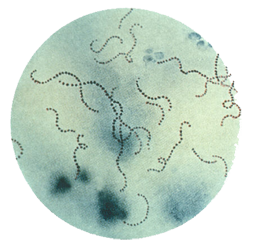Key points
- Streptococcus pyogenes are also called group A Streptococcus (group A strep bacteria).
- Group A strep bacteria can cause both noninvasive and invasive disease.
- They can also cause long-term sequelae.
- The bacteria are contagious and usually spread via respiratory droplets.
- Follow recommended guidelines when caring for patients with group A strep infection.

Guiding principles
Etiology
S. pyogenes are gram-positive cocci that grow in chains. They exhibit β-hemolysis (complete hemolysis) when grown on blood agar plates. They belong to group A in the Lancefield classification system for β-hemolytic Streptococcus, and thus are called group A streptococci.

CDC
Cause infections and immune-mediated sequelae
Learn about clinical features, complications, diagnosis, and treatment options for the following conditions related to group A strep bacteria.
Noninvasive diseases
Invasive diseases
Immune-mediated sequelae
Transmission
Transmission is most often direct person-to-person spread through respiratory droplets. It can also occur through contact with secretions (e.g., saliva, wound discharge, nasal secretions) from an infected person.
Although rare, spread of group A strep bacteria may also occur via food.
Environmental transmission via surfaces and fomites may be possible. However, it's likely a less common route of transmission.
How they don't spread
There's no evidence pets can transmit the bacteria to humans, the primary reservoir for group A strep bacteria.
Prevention
Prevention activities vary by condition, but generally focus on three important goals:
- Limit exposure and spread of bacteria
- Treat group A strep infections
- Use preventive antibiotics when appropriate
Surveillance and trends
CDC tracks invasive group A strep disease. Streptococcal toxic shock syndrome is the only nationally notifiable disease caused by group A strep bacteria.
